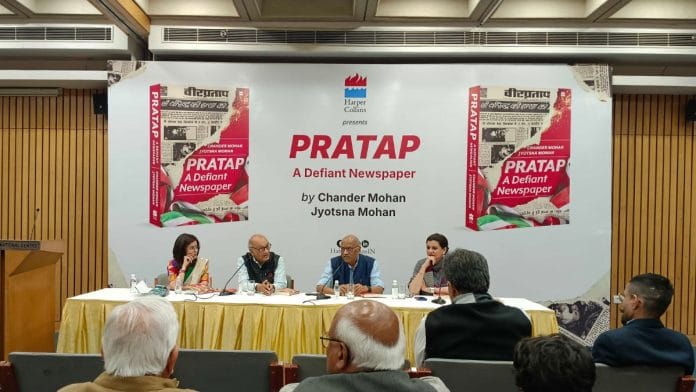New Delhi: Urdu newspaper Pratap was shut down within 12 days of its launch in March 1919—it reappeared only a year later. Its founders and editors were jailed multiple times for raising their voice against British rule. Over a century later, the daily has come to the limelight once again with the launch of the book, Pratap: A Defiant Newspaper.
Co-authored by journalists and father-daughter duo, Chander Mohan and Jyotsna Mohan, the book traces the journey of Pratap and its Hindi successor Vir Pratap. It celebrates historic moments in Indian journalism, also highlighting the role of the newspaper’s founders and editors.
Pratap was published between 1919 and 2017.
“Pratap is one of the great Indian institutions, which, unfortunately, was consumed by the way the markets changed,” said Shekhar Gupta, founder and editor-in-chief of ThePrint, stressing on the changing nature of journalism.
He also mentioned the importance of finding true evidence and talking to witnesses to truly understand an event before writing about it. “History is not written by martyrs. History is written by those who don’t get martyred,” Gupta said.
The event, held on 3 March at India International Centre in Delhi, was attended by journalists and senior editors. The panel included Chander Mohan and Jyotsna Mohan, Shekhar Gupta, and journalist Nidhi Razdan. The discussion went back to the Partition.
Congress MP Manish Tewari, who represents Chandigarh in the Lok Sabha, recalled how difficult it was for him to read the book, as it brought back painful memories of the Partition.
“Punjab suffered the most. Between Peshawar and Delhi, over 2 million people died—Hindus, Sikhs, Muslims—and 20 million were displaced, forced to relocate from their homes and hearths,” said Tewari.
The book covers the emotional and physical dislocation faced by the founders and editors of the newspaper, as well as ordinary people, during the harrowing time.
“This book has really captured the essence of Punjab’s pain. Punjab’s battle was never about Hindus against Sikhs. This was a battle instigated by the ISI, using a certain section of a disrupted populace,” Tewari added.
Revisiting the past
Chander Mohan (79), columnist at The Punjab Kesari, was also the Editor at Vir Pratap. He is the grandson of editor Mahashya Krishan, who started Pratap in Lahore. The author shared how difficult it was for him to recall the past and write about it. One such instance was when his office in Jalandhar was targeted through a parcel bomb in 1983 and two of his colleagues died in front of him.
“The most tough part was revisiting the pain of the parcel bomb that exploded in our office during the militancy. We had to relive those moments in order to share them with the world,” said Chander Mohan.
Jyotsna Mohan said it was difficult to convince her father to write the book.
“I realise how important it is to write down what we lived through, before the memory fades. And we felt that there was a story to be told and that is to tell now,” said Chandan Mohan.
Also read: ‘Congress high command demanded Partition, not Jinnah,’ says Cambridge historian
Changing media
The discussion also touched upon the importance of media and its changing nature. Using the example of the book, which provides a deep investigation of the past, senior journalist Nidhi Razdan said that the media has changed over time and lacks thorough investigation.
Gupta said that the ownership of media houses by businessmen, for whom it is not the main focus, has also changed its nature. “Media is a very small business. For all these guys who come in, media is only one half of, one tenth of, one per cent of their business.”
Chandan Mohan talked about the changing priorities and tastes of topics within newspapers and media houses. He recalled how, earlier, newspapers gave attention to the editorial on the front pages, but now that has shifted. “In our time, the editorial page was the main thing. People used to start with the editorial page. Now, in a basic English newspaper, a 20-page paper, the editorial page will be on page 18,” he said.
Gupta, however, also pointed out the positive side of these changes, highlighting how journalists are no longer confined to a particular type of work. They are now freer, and the medium has also expanded.
“There was a time when, if owners took away your job, they would also take away your audience. Now, you take your audience with you wherever you go,” he added. “So, there’s been a great empowerment of journalists, and all media is not finished.”
(Edited by Prasanna Bachchhav)







North-Indians have a thing for the Urdu language. They just can’t get over it.
But the fun part is the fact that Urdu is an over-hyped and over-celebrated language. Urdu poetry, literature and journalism is simply no match for regional languages such as Assamese and Bengali.
But the north-Indian is quite strangely fixated on Urdu.
Nobody invites Ravish Kumar these days. Poor guy. One cannot but feel for him.